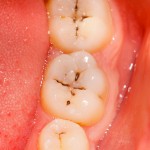
The traditional approach to carried management involved the removal of all softened dentine. This approach can lead to pulpal exposure an increased loss of pulp vitality. Two alternative approaches are increasingly being used, stepwise excavation which aims to removes all caries in two appointments, reducing exposure risk and partial caries removal (PCR), also known as incomplete caries removal.
The main aim of this review was to determine if permanent teeth with deep dentine caries treated with PCR differed in loss of pulp vitality and/or restorative failures compared to similar teeth treated with stepwise excavation.
Methods
Searches were conducted in the PubMed, Web of Science, Dentistry and Oral Sciences Source, and Cochrane Library databases. English language randomised controlled trials (RCTs), controlled clinical trials (CCTs), cohort studies, observational and case-series of permanent teeth with carious lesions that radiographically penetrates >50% dentine thickness beyond the amelodentinal junction published between 1980 and 2016 and followed up for a minimum of 2 years was considered.
2 reviewers independently selected studies, abstracted data and assessed study quality The Cochrane risk of bias tool was used for RCTs and the Newcastle- Ottawa scale (NOS) for observational studies.
Results
- 5 studies (2RCTs, 2 case-series, 1 retrospective) reported in 9 articles were included.
- A total of 426 permanent teeth were treated with PCR or stepwise excavation and observed over periods of 2–10 years.
- Both RCTs were considered to be at high risk of bias and the observational studies were of low quality.
- Regarding restorative failures, >88% success at two years for both techniques was reported.
- For loss of pulp vitality, observational studies reported >96% vitality at two years for each technique, while one RCT reported significantly higher vitality (p<0.05) at three years for PCR (96%) compared to SWT (83%).
Conclusions
The authors concluded
There is limited evidence that there are fewer pulpal complications over a three-year period when permanent teeth with deep dentine caries are treated with PCR rather than stepwise excavation. Any claim of a therapeutic advantage when treating permanent teeth with deep dentine caries using PCR rather than stepwise excavation. is supported by low numbers of studies consisting of limited- quality patient-oriented evidence. Successful vitality and restorative outcomes have been demonstrated for two years and beyond in permanent teeth with deep dentine caries treated with both techniques. Larger, long-term clinical studies that carefully follow diverse populations of participants are needed.
Comments
This review covers a similar topic to a Cochrane review by Ricketts et al published in 2013 (Dental Elf – 11th Apr 2013). Their review was restricted to RCTs and while they concluded
‘Stepwise and partial excavation reduced the incidence of pulp exposure in symptomless, vital, carious primary as well as permanent teeth. Therefore these techniques show clinical advantage over complete caries removal in the management of dentinal caries.
The included studies had a short follow up period. In comparison this review has looked at only those studies with a longer follow up period. This means that fewer studies of a lower quality are available and while the finding suggest that there are fewer pulpal complications after 3 years this should be interpreted cautiously until further higher quality evidence is available.
Links
Primary paper
Hoefler V, Nagaoka H, Miller CS. Long-term survival and vitality outcomes of permanent teeth following deep caries treatment with step-wise and partial-caries-removal: A Systematic Review. J Dent. 2016 Nov;54:25-32. doi: 10.1016/j.jdent.2016.09.009. Review. PubMed PMID: 27664467.
Other references
Dental Elf – 19th Sep 2013
Partial removal of caries as effective as stepwise removal in deep cavities
Dental Elf – 11th Apr 2013

Stepwise and partial-caries-removal –reduces longer term pulpal complications? https://t.co/HUd0oC9mif
Stepwise and partial-caries-removal reduces longer term pulpal complications? https://t.co/YtVBo0UIOC
Fewer pulpal complications with stepwise and partial-caries-removal https://t.co/YtVBo0UIOC
Stepwise and partial-caries-removal for deep dentine caries https://t.co/YtVBo0UIOC
Fewer pulpal complications with deep dentine caries using stepwise and partial-caries-removal https://t.co/YtVBo0UIOC
Don’t miss-Stepwise and partial-caries-removal –reduces longer term pulpal complications? https://t.co/YtVBo0UIOC